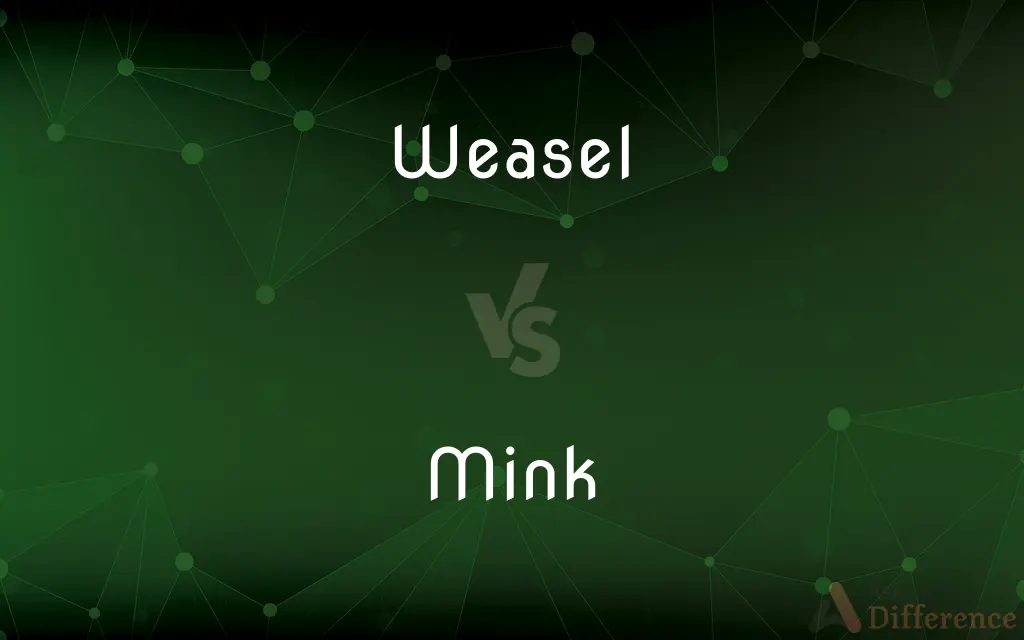Weasel vs. Mink — What's the Difference?
By Tayyaba Rehman & Urooj Arif — Updated on March 15, 2024
Weasels are small, nimble predators known for their slender bodies and versatility, while minks are larger, water-adapted relatives with luxurious fur.

Difference Between Weasel and Mink
Table of Contents
ADVERTISEMENT
Key Differences
Weasels are characterized by their small size, long slender bodies, and adaptability to a variety of environments, including forests, grasslands, and human-altered landscapes. They are known for their high metabolism and need to eat frequently. Whereas minks are similarly shaped but larger, and they have adapted to semi-aquatic environments. Minks have a denser, water-resistant fur, highly valued in the fashion industry, which has led to both wild and farmed populations.
Weasels are solitary animals, primarily active during the night (nocturnal) or at dawn and dusk (crepuscular), depending on the species. They rely on their agility and speed to catch prey, which includes rodents and small mammals. On the other hand, minks are also solitary but are known to be more aggressive, with diets that extend to fish, amphibians, and birds due to their semi-aquatic nature.
The reproductive behavior of weasels involves producing one litter per year, with the ability to delay implantation of embryos to ensure optimal birth conditions. In contrast, minks are capable of producing one to two litters per year without delayed implantation, indicating a difference in reproductive strategies that reflects their environmental adaptations.
Conservation status varies significantly between weasels and minks. While most weasel species are not currently at risk, specific populations face threats from habitat loss and fragmentation. Conversely, the American mink, especially in its wild form, is considered invasive in several regions outside its native range, affecting local ecosystems, whereas European mink populations are critically endangered, suffering from habitat loss and competition with farmed minks.
In terms of behavior, weasels are incredibly curious and energetic, known to explore and adapt to their surroundings effectively. Minks share this curiosity but are more adapted to aquatic environments, showcasing strong swimming abilities that complement their hunting strategies for aquatic prey.
ADVERTISEMENT
Comparison Chart
Size
Smaller, with a more slender body
Larger, with a thicker body
Habitat
Forests, grasslands, human-altered areas
Semi-aquatic environments, near water
Fur Quality
Less dense
Denser, water-resistant, valued in fashion
Diet
Rodents and small mammals
Fish, amphibians, birds, small mammals
Reproduction
One litter/year, with delayed implantation
One to two litters/year, no delay
Conservation Status
Mostly stable, some populations at risk
Varied, with invasive and endangered status
Behavior
Nocturnal or crepuscular, highly agile
Strong swimmers, adaptable to water
Compare with Definitions
Weasel
Characterized by a slender body.
The weasel's slender body allowed it to pursue prey into tight spaces.
Mink
Luxurious fur.
Mink fur is highly valued in the fashion industry for its density and softness.
Weasel
Solitary and territorial.
The weasel marks its territory to keep others at bay.
Mink
Larger than weasels.
Minks are noticeably larger and bulkier than their weasel relatives.
Weasel
Varied habitat preference.
Weasels can be found in forests, grasslands, and even near human dwellings.
Mink
Semi-aquatic carnivorous mammal.
The mink dived into the water to catch fish.
Weasel
Small carnivorous mammal.
The weasel stealthily hunted for mice in the barn.
Mink
Aggressive predator.
Minks are aggressive hunters, preying on a wide range of animals.
Weasel
High metabolic rate.
The weasel eats frequently to support its high metabolism.
Mink
Adapted to water.
The mink's webbed feet make it an excellent swimmer.
Weasel
Weasels are mammals of the genus Mustela of the family Mustelidae. The genus Mustela includes the least weasels, polecats, stoats, ferrets and mink.
Mink
Mink are dark-colored, semiaquatic, carnivorous mammals of the genera Neogale and Mustela and part of the family Mustelidae, which also includes weasels, otters, and ferrets. There are two extant species referred to as "mink": the American mink and the European mink.
Weasel
Any of various carnivorous mammals of the genus Mustela, having a long slender body, a long tail, short legs, and brownish fur that in many species turns white in winter.
Mink
Either of two semiaquatic mustelid carnivores, Mustela lutreola of Europe or Neovison vison of North America, having a pointed snout, short legs, and partly webbed toes. The North American species is bred for its commercially valuable fur.
Weasel
A person regarded as sneaky or treacherous.
Mink
The soft thick lustrous fur of a mink.
Weasel
To be evasive; equivocate.
Mink
A coat, stole, or hat made of this fur.
Weasel
The least weasel, Mustela nivalis.
Mink
(plural mink or minks) Any of various semi-aquatic, carnivorous mammals in the Mustelinae subfamily, similar to weasels, with dark fur, native to Europe and America, of which two species in different genera are extant: the American mink (Neovison vison) and the European mink (Mustela lutreola).
Weasel
Any of the carnivorous mammals of the genus Mustela, having a slender body, a long tail and usually a light brown upper coat and light-coloured belly.
Mink
(plural mink) The fur or pelt of a mink, used to make apparel.
Weasel
The taxonomic family Mustelidae is also called the weasel family.
Mink
(plural minks) An article of clothing made of mink.
Weasel
A devious or sneaky person or animal.
Mink
(plural minks) An individual with poor personal hygiene; a smelly person.
Weasel
A type of yarn winder used for counting the yardage of handspun yarn. It most commonly has a wooden peg or dowel that pops up from the gearing mechanism after a certain number of yards have been wound onto the winder.
Mink
A carnivorous mammal of the genus Mustela (foremrly Putorius), allied to the weasel. The European mink is Mustela lutreola. The common American mink (Mustela vison) varies from yellowish brown to black. Its fur is highly valued. Called also minx, nurik, and vison.
Weasel
(transitive) To achieve by clever or devious means.
Mink
The fur of the mink{1}. Together with sable, it is one of the most expensive furs not taken from endangerd species. When the fur is taken from animals grown on a farm, it called ranch mink.
Weasel
To gain something for oneself by clever or devious means.
Mink
The expensive fur of a mink
Weasel
(intransitive) To engage in clever or devious behavior.
Mink
Fur coat made from the soft lustrous fur of minks
Weasel
Small carnivorous mammal with short legs and elongated body and neck
Mink
Slender-bodied semiaquatic mammal having partially webbed feet; valued for its fur
Common Curiosities
Are weasels and minks solitary?
Yes, both are solitary animals but may come together during mating season.
What do weasels and minks eat?
Weasels primarily eat rodents and small mammals. Minks have a broader diet that includes fish, amphibians, and birds.
What are the main physical differences between weasels and minks?
Weasels are smaller with less dense fur, whereas minks are larger with water-resistant, luxurious fur.
Where do weasels and minks live?
Weasels adapt to a variety of habitats including forests and grasslands, while minks live near water in semi-aquatic environments.
How do weasels and minks reproduce?
Weasels have one litter per year with delayed implantation. Minks can have one to two litters per year without delayed implantation.
Can weasels swim?
Weasels can swim but are not as adapted to aquatic life as minks.
What role do weasels and minks play in the ecosystem?
They are important predators, controlling populations of rodents and other small animals.
Are minks farmed for their fur?
Yes, minks are farmed extensively for their dense and luxurious fur.
What is the conservation status of weasels and minks?
Weasels are mostly stable, but some populations are at risk. Minks have varied statuses, with some being invasive and others endangered.
Do weasels and minks have natural predators?
Both have natural predators, including larger mammals and birds of prey.
How do the diets of weasels and minks differ?
Weasels mainly eat small mammals, while minks' diets also include aquatic creatures.
What is delayed implantation in weasels?
It's a reproductive strategy where the embryo's development is paused to ensure offspring are born at an optimal time.
Can weasels and minks be kept as pets?
While some species might be kept as pets under specific conditions, they are generally not recommended due to their wild nature and specific care needs.
How do weasels and minks hunt?
Weasels rely on their agility and speed, while minks use their swimming ability to catch prey.
Why are minks considered invasive in some areas?
Released or escaped farmed minks can establish wild populations that disrupt local ecosystems by preying on native species.
Share Your Discovery

Previous Comparison
Pride vs. Proudness
Next Comparison
Gratuity vs. BonusAuthor Spotlight
Written by
Tayyaba RehmanTayyaba Rehman is a distinguished writer, currently serving as a primary contributor to askdifference.com. As a researcher in semantics and etymology, Tayyaba's passion for the complexity of languages and their distinctions has found a perfect home on the platform. Tayyaba delves into the intricacies of language, distinguishing between commonly confused words and phrases, thereby providing clarity for readers worldwide.
Co-written by
Urooj ArifUrooj is a skilled content writer at Ask Difference, known for her exceptional ability to simplify complex topics into engaging and informative content. With a passion for research and a flair for clear, concise writing, she consistently delivers articles that resonate with our diverse audience.














































